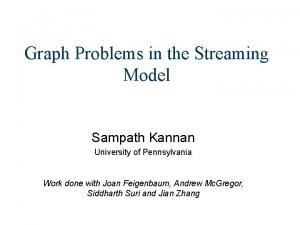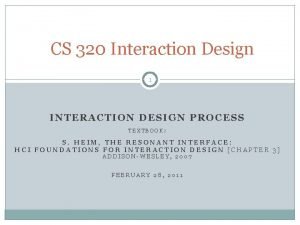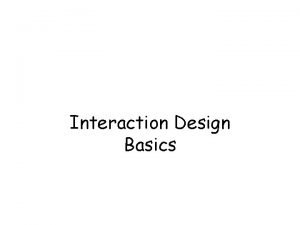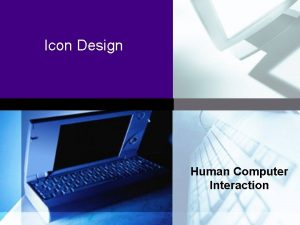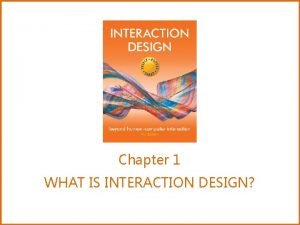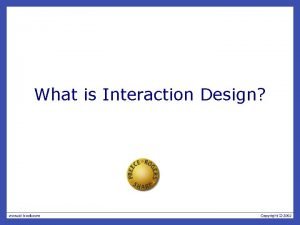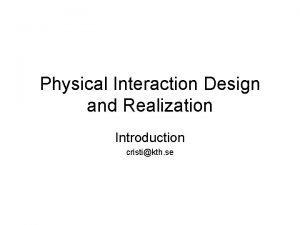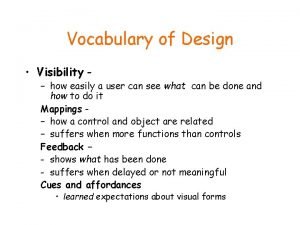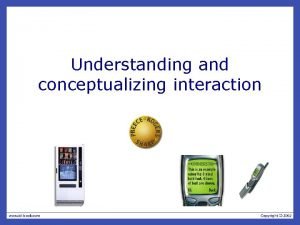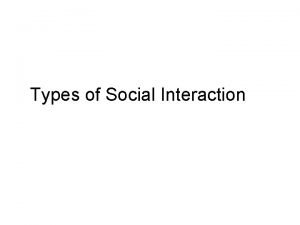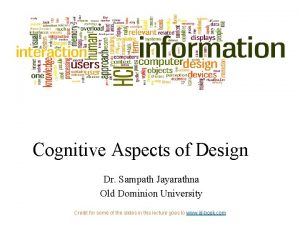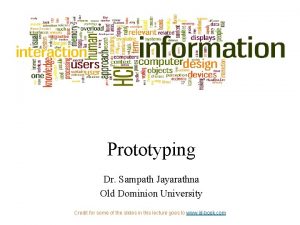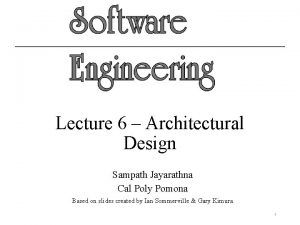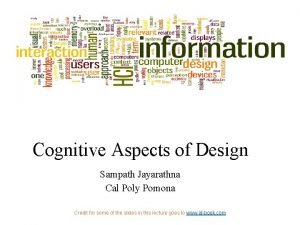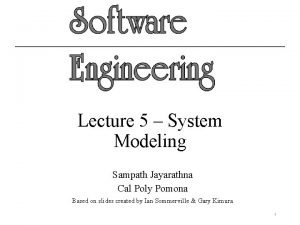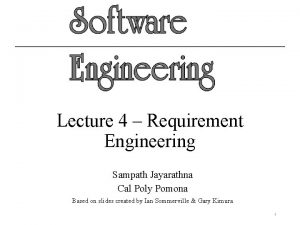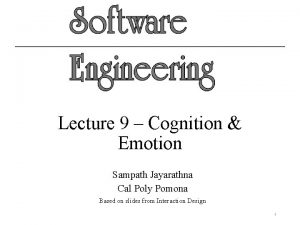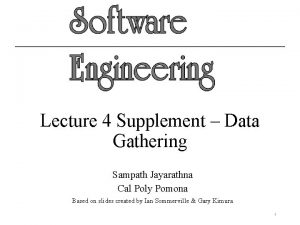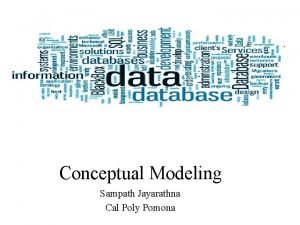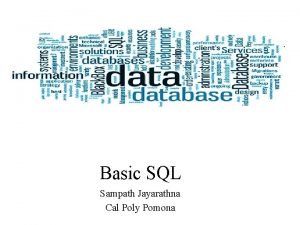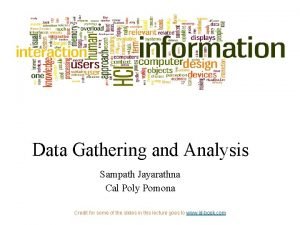Lecture 1 Interaction Design Dr Sampath Jayarathna Old













































- Slides: 45

Lecture 1 - Interaction Design Dr. Sampath Jayarathna Old Dominion University Credit for some of the slides in this lecture goes to www. id-book. com

What is interaction design? “Designing interactive products to support the way people communicate and interact in their everyday and working lives. ” • Preece, Sharp and Rogers (2015), (Interaction Design Book) “The design of spaces for human communication and interaction. ” • Winograd (1997), (Stanford HCI Group) 2

Goals of interaction design • Develop usable products • Usability means easy to learn, effective to use and provide an enjoyable experience • Involve users in the design process • Number of other terms used emphasizing what is being designed, e. g. • user interface design, software design, user-centered design, product design, web design, experience design (UX) 3

HCI and interaction design • Interaction design is the umbrella term covering all of these aspects • fundamental to all disciplines, fields, and approaches concerned with researching and designing computer-based systems for people 4

Bad designs Elevator controls and labels on the bottom row all look the same, so it is easy to push a label by mistake instead of a control button People do not make same mistake for the labels and buttons on the top row. Why not? 5

Good design • Marble answering machine (Bishop, 1995) • Based on how everyday objects behave • Easy, intuitive and a pleasure to use • Only requires one-step actions to perform core tasks • http: //viewpure. com/Rg. Vb. XV 1 krg. U? start=0&end=0 6

Activity 2 • The Marble Answering Machine (by Durell Bishop, student at the Royal College of Art) is a prototype telephone answering machine. The Marble Answering Machine demonstrates the great potential of making digital information graspable. • Find a partner. • Discuss and write down what is good and bad about the way this design works compared to regular voice mail systems (say your mobile service). • Submit your answers to Piazza thread. Don't forget to write both your names on your post!

What to design • Need to take into account: • Who the users are • What activities are being carried out • Where the interaction is taking place • Need to optimize the interactions users have with a product: • So that they match the users’ activities and needs • Product success depends on designing systems/tools that can be used 8

Understanding users’ needs • Need to take into account what people are good and bad at • Consider what might help people in the way they currently do things • Think through what might provide quality user experiences • Listen to what people want and get them involved • Use tried and tested user-centered methods 9

Bad design results in • Anger and frustration • Decreased productivity in the workplace • Higher error rates • Physical and emotional injury • Equipment damage • Loss of customer loyalty • Costs money 10

Working in multidisciplinary teams • Many people from different backgrounds involved • Different perspectives and ways of seeing and talking about things • Benefits • more ideas and designs generated • Disadvantages • difficult to communicate and progress forward the designs being create 11

What do professionals do in the ID business? • interaction designers - people involved in the design of all the interactive aspects of a product • usability engineers - people who focus on evaluating products, using usability methods and principles • web designers - people who develop and create the visual design of websites, such as layouts • information architects - people who come up with ideas of how to plan and structure interactive products • user experience designers (UX) - people who do all the above but who may also carry out field studies to inform the design of products 12

The User Experience • How a product behaves and is used by people in the real world • the way people feel about it and their pleasure and satisfaction when using it, looking at it, holding it, and opening or closing it • “every product that is used by someone has a user experience: newspapers, ketchup bottles, reclining armchairs. ” • Cannot design a user experience, only design for a user experience 13

Why was the i. Pod user experience was such a success? • Quality user experience from the start • Simple, elegant, distinct brand, pleasurable, must have fashion item, catchy names, cool, etc. 14

Simple Interaction Design Lifecycle Model • • Establishing requirements Developing alternatives Prototyping Evaluating 15

Core characteristics of interaction design • Users should be involved through the development of the project • Specific usability and user experience goals need to be identified, clearly documented and agreed at the beginning of the project • Iteration is needed through the core activities 16

You are not your user!!! • Seems obvious but… • You have different experiences • You have different terminology • You have different ways of looking at the world • Fatal mistakes • Assume all users are alike • Assume all users are like the designer, …. . especially YOU! 17

Why go to this length? • Help designers: • understand how to design interactive products that fit with what people want, need and may desire • appreciate that one size does not fit all e. g. , teenagers are very different to grown-ups • identify any incorrect assumptions they may have about particular user groups e. g. , not all old people want or need big fonts • be aware of both people’s sensitivities and their capabilities 18

Cultural differences and accessibility • 5/21/2015 versus 21/5/2015? • Which should be used for international services and online forms? • Accessibility: Degree to which a product is usable and accessible by as many people as possible • • • Focus on disability Have a mental or physical impairment This has an adverse affect on their everyday lives It is long term https: //www. washington. edu/doit/sites/default/files/atoms/files/Designing -Software-Accessible-Individuals-Disabilites. pdf 19

Usability goals • Effective to use (doing the right thing) • How good a product is at doing what it is supposed to do • Efficient to use (doing things right) • Product supports users carrying out their tasks efficiently. , Amazon One-Click • Safety • Safe to use • Have good utility • Product provides a right kind of a functionality so users can do what they need or want to do • Learnability • Easy to learn • Memorability • Easy to remember how to use 20

User experience goals Desirable aspects satisfying enjoyable engaging pleasurable exciting entertaining helpful motivating challenging enhancing sociability supporting creativity cognitively stimulating Undesirable aspects boring frustrating making one feel guilty annoying childish fun provocative surprising rewarding emotionally fulfilling unpleasant patronizing making one feel stupid cutesy gimmicky 21

Activity 3 • Selecting terms to convey a person’s feelings, emotions, etc. , can help designers understand the multifaceted nature of the user experience • Find a partner. • Discuss and find the answers to the following. Submit to piazza. • How do usability goals differ from user experience goals?

Design principles • Generalizable abstractions for thinking about different aspects of design • The do’s and don'ts of interaction design • What to provide and what not to provide at the interface • Derived from a mix of theory-based knowledge, experience and common-sense 23

Design principles • Visibility – Can I see it? • Feedback – What is it doing now? • Constraint – Why can't I do that? • Consistency – I think I have seen this before? • Affordance – how do I use it? • Mapping – Where am I and where can I go? 24

Visibility • This is a control panel for an elevator • How does it work? • Push a button for the floor you want? • Nothing happens. Push any other button? Still nothing. What do you need to do? • It is not visible as to what to do! 25

Visibility …you need to insert your room card in the slot by the buttons to get the elevator to work! How would you make this action more visible? • make the card reader more obvious • provide an auditory message, that says what to do (which language? ) • provide a big label next to the card reader that flashes when someone enters • make relevant parts visible • make what has to be done obvious 26

The case of the mistaken urinal 27

The case of the mistaken urinal 28

Visibility • Car Controls are positioned in a way that they can be easily found and used 29

Visibility • Hiding certain functions can be advantageous in interface design • Certain functions are kept invisible until needed; also contained within group of similar types • Google Search makes it clear where to enter text 30

Feedback • Sending information back to the user about what has been done • Includes sound, highlighting, animation and combinations of these • Needs to be immediate and synchronized with user action • e. g. when screen button clicked on provides sound or red highlight feedback: 31

Constraints • Restricting the possible actions that can be performed • Helps prevent user from selecting incorrect options or reduce chance of an error • Can also work to focus user's attention to needed task • Physical objects can be designed to constrain things • e. g. only one way you can insert a key into a lock 32

Logical or ambiguous design? • Where do you plug the mouse? • Where do you plug the keyboard? • top or bottom connector? • Do the color coded icons help? 33

How to design them more logically (i) A provides direct adjacent mapping between icon and connector (ii) B provides color coding to associate the connectors with the labels 34

Consistency • Design interfaces to have similar operations and use similar elements for similar tasks • For example: always use ctrl key plus first initial of the command for an operation – ctrl+C, ctrl+S, ctrl+O • Main benefit is consistent interfaces are easier to learn and use • Enable people to quickly transfer prior knowledge to new context and focus on relevant tasks 35

Aesthetic and Functional consistency • Aesthetic • Style and appearance is repeated to enhance recognition, communicates membership and sets emotional tone • Benz: instantly recognizable because consistently features its logo • Functional • Meaning and action are consistent to improve learnability and understanding • Traffic always turns yellow before red. • Cassette recorder control symbols used 36

Internal and external consistency • Internal consistency refers to designing operations to behave the same within an application • Consistency with other elements in the system • External consistency refers to designing operations, interfaces, etc. , to be the same across applications and devices • More difficult to achieve because different systems rarely observe the same design standards. • Extends the benefit of internal consistencies across multiple, independent systems 37

When consistency breaks down • What happens if there is more than one command starting with the same letter? • e. g. save, spelling, select, style • Have to find other initials or combinations of keys, thereby breaking the consistency rule • e. g. ctrl+S, ctrl+Sp, ctrl+shift+L • Increases learning burden on user, making them more prone to errors 38

Affordances: to give a clue • Perceived and actual properties of an object that give clues to its operation • e. g. a mouse button invites pushing, a door handle affords pulling • Since has been much popularised in interaction design to discuss how to design interface objects • e. g. scrollbars to afford moving up and down, icons to afford clicking on 39

What does ‘affordance’ have to offer interaction design? • Interfaces are virtual and do not have affordances like physical objects • Instead interfaces are better conceptualized as 'perceived' or 'virtual' affordances 40

Mapping • Controls and displays should exploit natural mapping • Natural mapping takes advantage of physical analogies and cultural standards • Physical : Steering wheel • Cultural: red means stop, green means go 41

What about Software? • Visibility: Visibility of tasks the UI supports and communication of system state/mode • Affordance: If it looks like a button it can be pressed, if it is underlined, it can be clicked • Mapping: Clicking on particular UI element produces expected effect • Constraints: Constraining search criterial, greying out menu items that don't display in a particular context • Feedback: Provide clear and immediate feedback for each action, animated icons for any waiting Many more examples of these that we will see during the semester…………. 42

Larson's dog effect 43

How do we learn about users? • People skim ruthlessly – particularly in online environments. • If possible, they avoid reading entirely. • If there are usability problems in everyday 'simple' things, this makes it a much greater challenge for complex software • Problems can overcome through HCI methods that collect and analyze data to better understand your users. • There are many methods, we will learn and practice few • • Surveys Contextual inquiry Interviews Usage Analysis 44

Activity 4 • This assignment is intended for you to put into practice what you have read about todays lecture. Specifically, the objective is to enable you to define usability and user experience goals and to transform these and other design principles into specific questions to help evaluate an interactive product. • Think about our Startup project idea, and examine how we should design this, paying particular attention to how the user is meant to interact with it. a) From your first impressions, write down what first comes to mind as to what is good and bad about the way the interaction works. b) Compile a set of usability and user experience goals that you think will be most relevant in evaluating this project. Decide which are the most important ones and explain why. c) Finally, discuss possible design principles applicable to this project interface.
 Processing
Processing Sampath kannan
Sampath kannan P sampath
P sampath Sanjay sampath
Sanjay sampath Srinidhi sampath kumar
Srinidhi sampath kumar 01:640:244 lecture notes - lecture 15: plat, idah, farad
01:640:244 lecture notes - lecture 15: plat, idah, farad What's your name how old are you
What's your name how old are you Once upon a time there lived a
Once upon a time there lived a Once upon a time there lived an old man and an old woman
Once upon a time there lived an old man and an old woman Once upon a time there lived a very poor boy
Once upon a time there lived a very poor boy Understanding the problem space
Understanding the problem space Interaction design basics
Interaction design basics Interaction design process
Interaction design process Interaction design process
Interaction design process Interaction design lifecycle model
Interaction design lifecycle model A simple interaction design lifecycle model
A simple interaction design lifecycle model Interaction design syllabus
Interaction design syllabus Interaction design basics
Interaction design basics Icon in hci
Icon in hci Simple interaction design lifecycle model
Simple interaction design lifecycle model The process of interaction design
The process of interaction design Interaction design basics
Interaction design basics Interaction design process in hci
Interaction design process in hci Goals of interaction design
Goals of interaction design A simple interaction design lifecycle model
A simple interaction design lifecycle model Elements of the wimp interface
Elements of the wimp interface Four basic activities of interaction design
Four basic activities of interaction design Interaction design
Interaction design How do these screen objects afford
How do these screen objects afford Physical interaction design
Physical interaction design Physical interaction design
Physical interaction design Visibility in interaction design
Visibility in interaction design Practical design to eurocode 2 lecture 3
Practical design to eurocode 2 lecture 3 Elemen urban design
Elemen urban design Interior design lecture notes+ppt
Interior design lecture notes+ppt Lecture hall acoustic design
Lecture hall acoustic design Game design lecture
Game design lecture Computer-aided drug design lecture notes
Computer-aided drug design lecture notes Cmos vlsi design lecture notes
Cmos vlsi design lecture notes Gauche interaction in chair conformation
Gauche interaction in chair conformation What is real time interaction management
What is real time interaction management Total physical interaction
Total physical interaction Hci interaction styles
Hci interaction styles Understanding and conceptualizing interaction
Understanding and conceptualizing interaction Cooperation social interaction
Cooperation social interaction In every action there is an interaction
In every action there is an interaction

